Adventure
 'I believe any trip in search of wildlife can be coupled with physical activity and elements of cultural diversity to form a thrilling opportunity ' 'I believe any trip in search of wildlife can be coupled with physical activity and elements of cultural diversity to form a thrilling opportunity '
John H.Eickert |
I have this strange life-long fascination with flamingos. I have no idea where I got it or even when it started. I have two plastic pink flamingos in our yard here in Montana . One of them has been with me to the glaciers of Alaska
, South America , and Nepal . For me it is reassuring to see a pink flamingo, even a plastic one, when camped on ice at altitude. But I still don't know where the fascination began, only that I need to satisfy my desire to watch and listen to flamingos. Years
ago, in Chennai, I listened to a man talk about all the flamingos he had seen at a place called, Point Calimere. Of course, I had to go and see for myself.
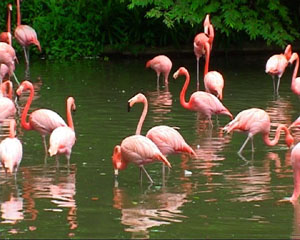 Point Calimere is a wildlife refuge and bird sanctuary on the middle east coast of India , south of Chennai. It was January and I saw a great number of flamingo's, and a lot more. This place, known to locals as Kodiakkarai, is
a meeting of three distinct habitats, dry evergreen forest, mangrove swamp, and wetland. It is just across the strait from Sri Lanka and is geologically a low headland. In addition to flamingos, it is a great place to observe blackbuck and watch dolphins.
Over 425 specie of bird has been identified at Calimere. I think I counted about 40 as we bobbed across the sand in a TATA Sumo. One of the best places at Calimere to watch and listen for birds is at the fringe of the habitat interfaces, especially along the
Cauvery River . Even thought the sanctuary is fairly small deer are plentiful and there are some wild horses as well. And that's not all. Point Calimere is a wildlife refuge and bird sanctuary on the middle east coast of India , south of Chennai. It was January and I saw a great number of flamingo's, and a lot more. This place, known to locals as Kodiakkarai, is
a meeting of three distinct habitats, dry evergreen forest, mangrove swamp, and wetland. It is just across the strait from Sri Lanka and is geologically a low headland. In addition to flamingos, it is a great place to observe blackbuck and watch dolphins.
Over 425 specie of bird has been identified at Calimere. I think I counted about 40 as we bobbed across the sand in a TATA Sumo. One of the best places at Calimere to watch and listen for birds is at the fringe of the habitat interfaces, especially along the
Cauvery River . Even thought the sanctuary is fairly small deer are plentiful and there are some wild horses as well. And that's not all.
At the high point along the coast is a place known as Ramarpatham, in the Tamil language. On that spot, which cannot be more than five meters above sea level, are two tiny foot prints set in stone. Legend says the prints were left
by Rama. The indentations in the stone are clearly visibly and lead the viewer to conclude that Rama was either very young when he left them or was not a large man. There are also two interesting light houses. The younger one looks like a light house a person
might see along the eastern seaboard of North America . It is white with a red roof and has a commanding view. The other is small and sits on the beach. It is considered to be over 1000 years old and was built by the ‘Chola Kings' who ruled Tamil Nadu. From
what I have read in the news, this older light house was badly damaged by the recent tsunami. I have also read that much of Calimere was under water for a brief period. We will wait and see what effect the tsunami will have on the migratory bird life, especially
the flamingos.
I hope each of you takes the time to visit, remember winter is the best time. Cheers.
( Flamingos- Susan Sharma)
|
Answers To Quiz Of The Month
This month no one have given all right answers.
Right Answer toQuiz on Raptors
|
| 1.A raptor is a . ……………………….. |
|
has a hooked beak |
meat eating bird |
both the above are correct
|
|
| 2.Out of the 482 species of raptors worldwide ------------------are nocturnal |
|
| 3.This owl can be spotted in Bharatpur and Sultanpur Bird sanctuaries. |
|
Great horned owl |
Barn owl |
Collared scoops owl
|
|
| 4.A common hawk found in India, this raptor eats frogs, lizards, mice and squirrels. The male is ashy blue grey and female is brown. Its size is a little bigger than a blue rock pigeon. |
|
Shikra |
Common hawk cuckoo |
Ferrunginous hawk
|
|
| 5.Though uncommon in the Konkan and Malabar area, the Crested Serpent Eagle can be spotted on trees in the |
|
Corbett National Park |
KedarNath Wildlife Sanctuary |
Kaziranga National Park
|
|
| 6.Distributed in India in the Malabar and Konkan region, this raptor eats, among other things, honey, wax and bee-larvae of the ferocious rock bees. |
|
Western marsh harrier |
Oriental Honey-Buzzard |
White-eyed buzzard
|
|
| 7.This falcon breeds in he Himalayas and NE India and is a look alike of the shikra |
|
Eurasian sparrowhawk |
Osprey |
Changeable hawk-eagle
|
|
| 8.This globally threatened eagle is a winter visitor in the wetlands of Haryana |
|
Imperial eagle |
Greater spotted eagle |
Tawny eagle
|
|
| 9.A study by Bombay Natural History Society found that the population of two common species of these scavenging vultures have gone down by 90% over a decade. |
|
Bearded vulture |
Asian white backed vulture |
Himalayan Griffon
|
|
| 10.Jatayu and Sampati, in the epic Ramayana, who helped rama when Sita was abducted by Ravana , were, |
|
Please try our quiz for the current month on
Bears
|
Burning Issues
- Shivani Thakkur
March 22 was celebrated, as WORLDWATER DAY .The task was to highlight merits of rainwater harvesting and save us from future water problems.
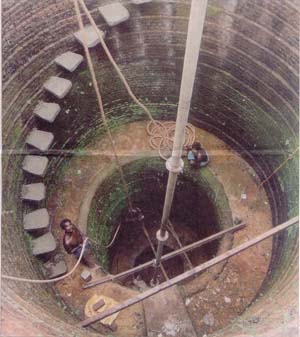 Our country is interspersed by rivers. Yet, we face water shortage not only in urban areas but also rural areas. The population growth, loss of green cover, lack of rains, abandoning ancient techniques of water conservation have
all resulted in this crisis. In urban India where water supply is less than amount required lot of it is wasted in transit. Bad supply links has led to water shortage and problem is solved only by water tankers or bore wells. The adverse effect of bore wells
results in ground water depletion. The worst effect is that water table never gets replenished because of lack of rains and also because there are no means of collecting it. In rural areas tube wells rule where there is no water supply. This results in water
crisis. Our country is interspersed by rivers. Yet, we face water shortage not only in urban areas but also rural areas. The population growth, loss of green cover, lack of rains, abandoning ancient techniques of water conservation have
all resulted in this crisis. In urban India where water supply is less than amount required lot of it is wasted in transit. Bad supply links has led to water shortage and problem is solved only by water tankers or bore wells. The adverse effect of bore wells
results in ground water depletion. The worst effect is that water table never gets replenished because of lack of rains and also because there are no means of collecting it. In rural areas tube wells rule where there is no water supply. This results in water
crisis.
The worst part is that people have abandoned age-old tradition of maintaining wells and ponds. This results in deposition of silt, which in turn dries up the water sources. To combat our water shortage, we have to recharge the ground
water. We have to go back to traditional method of conserving water. Since our climate has changed, rainfall has dwindled and rivers dried up; our only hope is to conserve and preserve every precious drop of drinkable water. Water harvesting can play a major
role in this. And people have realized its potential. In urban areas, the state government has passed laws that all new buildings are to have water-harvesting units. Many colonies have adopted this and have been able to raise the ground water table. The existences
of old baolis in and around Delhi are being desilted. Although a lot of work is required, it is a step in the right direction.
In rural areas also work has started. In Gujarat where drought prevailed, check dams were made. At the time of rains water collected helped them to ride the tide. Similarly in Kerala in Kasargod district, ‘Surungam”or tunnels are built
through hillocks. These Surungam are horizontal wells where water seeps in from sides. The water collected is carried through pipes into tanks outside from where it is redirected for domestic use. These have helped in ensuring adequate water supply. These
various techniques like zings in Ladakh,kuls and naulas in Himachal and Uttranchal, bamboo drip irrigation baolis can help us with our water crisis all over the country. All that is needed is a little ingenuity on our parts.
( The telling picture by Bijoy Ghosh appeared in “The Hindu”)
|
Common Birds of India
by - Ragoo Rao
A neat black and white bird, the size of a bulbul with cocked tail, hopping around home gardens is sure to have been noticed by many urbanites. The female is of the same size but the black color of the male is replaced with brown
and grey. It is a common bird in India except in very arid regions. Minor colour and size differentiates the four races we have in India .
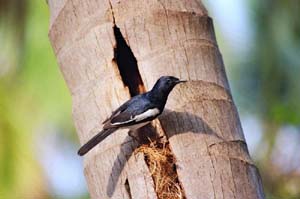 Normally a shy bird but the male could be quite aggressive during mating and nesting season. Any intruder like a person or a dog is not tolerated by the male. They dive-bomb with a loud kkrrrrrrrr... call to ward them off. The
males are lusty singers. One can hear them as early as 4 in the morning. They sing beautifully, from their favourite tree-top or a fence. The songs are punctuated with the upward flicking of their tails. Sometimes the male mimics other birds too. A very territorial
bird, will chase away any intruding males with puffed-up feathers and a loud chhuuuurrr... sound. If one could observe these birds for some time it is very easy to understand their body language and also their vocalizations. Normally a shy bird but the male could be quite aggressive during mating and nesting season. Any intruder like a person or a dog is not tolerated by the male. They dive-bomb with a loud kkrrrrrrrr... call to ward them off. The
males are lusty singers. One can hear them as early as 4 in the morning. They sing beautifully, from their favourite tree-top or a fence. The songs are punctuated with the upward flicking of their tails. Sometimes the male mimics other birds too. A very territorial
bird, will chase away any intruding males with puffed-up feathers and a loud chhuuuurrr... sound. If one could observe these birds for some time it is very easy to understand their body language and also their vocalizations.
The main food of the magpie-robins is insects mainly picked up from the ground from lawns and mud heaps. Sometimes it is noticed they try to break open the hard shell of beetles by slamming them frequently to the ground.
Erythrina flower nectar is also liked by them in season.
The main breeding season is from April to July. The nest usually a hollow in a tree and lined with feathers and rags picked up locally.3-5 pale blue-green blotched eggs are laid and both parents take part in incubation and all domestic
chores. The female does more of the incubation while the male stands sentinel on a nearby branch and feeds her also during this time. In about three weeks of continuous feeding the chicks grow up and fledge.
A wonderful bird, which can be invited to your garden with water-troughs and non-intrusive ways of observing them.
( Magpie Robin on nest –Photo by Ragoo Rao)
|
Gardening for wildlife
-Promila Chaturvedi
Mulch your garden
• After mowing your lawn spread the cut grass in shrubbery and over the tree base. It slows down the water evaporation.
• Do not throw away your garden waste. Compost it and use it in shrubbery, flowerbeds and on tree basin to cover. Even without composting you can use the dry leaves and other fine material to cover the area near plant roots.
• Do not throw away kitchen waste. It can easily be composted. And in hot weather within a month's time the compost is ready to mulch your plants.
• Cow dung manure or other compost, which is available in the market, is also used for mulching the garden plants.
• Tree bark, if available, is used as mulch.
• In some cases pebbles are also used for mulching.
• Plants like tradescantias and buddleias are also used.
Beautiful Garden with minimum use of water
• Use of sprinkler Irrigation system and Drip Irrigation sharply reduce the water requirement. Though it is viable in gardens of bigger size.
• When garden is getting developed, try to install these systems at the same time. Once garden features are made get the Irrigation and drip system installed. Get the plantation and grassing completed.
• With drip use there will be almost no weeds in plants, while sprinklers not only irrigate the garden with less water but the plants and trees will look fresh and clean.
• A chemical-Agro Absorb- is also available in the market. It reads “add it to the soil and rake it and water the ground.” It is said “ It reaches the roots of the plants- while plants are watered it becomes some what like jelly and does not allow water to
dry quickly”.
( Picture: tradescantia)
|
News and Views
News………………
Wildlife and environmental issues seem to be finally getting due attention by the media, thanks to the alarming possibility of losing our wild fauna to poachers and developers! We have started a weekly column “ Press this week” which
gives a brief overview of the press reports in various newspapers in India. The column is written by Anuradha Sharma. Anuradha has a Master’s in Biological Anthropology from University of Cambridge, U.K. She has also worked as an intern with the Durrel Wildlife
Conservation Trust, Jersy Zoo, U.K. Thank you Anuradha for lending your expertise on a voluntary basis! Click on the button on the right hand side of the home page every Monday/Tuesday to keep yourself abreast with issues which have caught media attention.

A widely traveled Plantation Consultant and bird enthusiast, Ragoo Rao will write a column on Common Birds of India. His own observations in the field complemented by some beautiful photographs he has taken promise to be a treat for
all bird watchers-experts and amateurs alike. His first article appears in this issue.
Temperatures in Northern parts of India are soaring upwards of 40 degree centigrade. Can water shortage be far behind? Promila’s article on maintaining your garden with minimum use of water is timely and useful. Also read "Water-Return
to Tradition"a serious look at the water situation.
Saraswati’s trek on foot continues with more ground realities staring at all of us.
There is an addition to our NGO page. The World Pheasant Association, India chapter has recently launched a very informative website, a brief introduction to which can be read on our NGO page.Click
here to read it.
And Views...........
Presently, groundwater is treated as property of the overlying land owner in many parts of California. But, as population pressures rise, stresses on the environment mount, and the potential for long-term drought looms, science points
out that groundwater cannot be separated from surface water. Gradually, groundwater is being recognized in California as being within the spirit of public trust, if not within its legal scope. Legislative actions are being taken to encourage integrated management,
programmes for conjunctive use of surface water and groundwater, and establishment of monitoring stations. If one looks at the Chennai and Bangalore metropolitan areas, the groundwater situation is analogous to that of California a century ago. Economic considerations
are driving groundwater extraction. Because of the hard-rock geological conditions of these areas, surface water and groundwater are intimately interlinked. The people of these areas would gain much by following the lead of communities such as Santa Clara
County and Orange County to develop plans for integrated management of surface water and groundwater, complemented by artificial recharge, conjunctive use, conservation strategies, and public education.
From what we know of groundwater occurrence, it is unwise to engage in uncontrolled groundwater extraction. Although overdraft may initially provide some short-term relief, long-term societal costs will be high.
India has historical traditions of having respect and reverence for water and nature. Remarkably, the western doctrine of public trust is philosophically quite compatible with India's cultural past. India needs to formally recognize
the importance of water and have the will to articulate it. The judiciary and the government must have necessary authority to ensure that surface water and groundwater are managed wisely for the benefit of the people.
A logical first step is to amend India's Constitution to incorporate public trust in regard to water in a form that is compatible with the country's cultural history.
By T.N. Narasimhan
The Hindu | May 3, 2005
http://www.hindu.com/2005/05/03/stories/2005050302331100.htm
(The writer is Professor, Materials Science and Engineering Environmental Science, Policy and Management, University of California at Berkeley.)
|
Story Of The Month
( Contd. from previous Ezine)
By - Saraswati Kavula
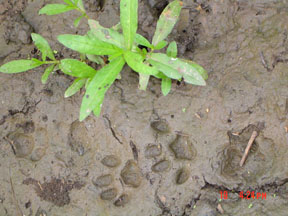 The next day we went to bird watch in the forest surrounding the Maisampet area. It was about a five kilometer route all together. We managed to see some typical plant species of the region and some rare birds. As usual the river
inside the forest was dried up. And even siltation has occurred. “See they have made the huge check dam higher up and this whole place is silted now”. Imran pointed out. The next day we went to bird watch in the forest surrounding the Maisampet area. It was about a five kilometer route all together. We managed to see some typical plant species of the region and some rare birds. As usual the river
inside the forest was dried up. And even siltation has occurred. “See they have made the huge check dam higher up and this whole place is silted now”. Imran pointed out.
On one of the trees we found bear marks, he must have tried very hard to get on the tree and reach the honey comb that was right on the edge of the thin branch. Every one was delighted. There was a double bonanza. We found pug marks
of the wild boar, and also the scats of tiger. “How can you make out it was done by the tiger?” one of the participants inquired. “Can you see there is fur of the Sambhar inside this stool? Only a tiger can eat a Sambhar and digest its fur. The tiger has a
rough tongue so it first licks out the fur and then eats the animal. We normally use the pug marks and collect the scats when we do the Census of the tiger”, Imran replied. The boys from the conservation group were very thrilled. It has been a bonanza this
is proof enough that the tiger is alive here and it means an entire eco-system is surviving.
We had our breakfast of fruit bread and biscuits inside the forest. But everyone took care not to throw around any trash inside the forest. We sat down and our talk turned to conservation. Each one had their own ideas. Imran asked
people to join his voluntary group, “Hyderabad Tiger Conservation Society”. But there weren't many takers. “We cannot be as dedicated as you are and give so much time. More over everyone need not do the same thing you know.” “Well you don't do anything for
the tiger conservation; just at least do something for the birds that you come to watch!” Imran asked again.
“Well it all depends on the inner motivation, how can everyone be like you? We all are doing different things!” One of the girls tried to reason out. What she meant was that she was happy to bird watch and come to the forest for the
thrill of it, but not bother to do
anything about conservation work. That was the saddest part, to see the apathy of people to come forward and do something about the destruction that is happening around us.
One of them was a freelance writer. Imran asked her, ‘Can you write about this trip to publish it somewhere, so we can generate interest in the public on these matters?” “Well, who can write so much, two-three pages is a little too
much, to write about it don't you think?” she replied. That is the basis for my writing this story.
By noon , we reached the village. The DFO* of Jannaram, Mr.Vinod Babu had come to the village. We all sat on the ‘charpais' to have tea and talk while the lunch was being made. Imran and Vinod Babu started to exchange information about
the situation in the forest. Vinod Babu told us about the problems of resettling people. After promising to take our entire luggage back to Jannaram in his jeep and also one of the injured participants, he left saying that he shall send the jeep in an hour
back to us. Seetabai made an absolutely fabulous lunch. It was surely one of the best meals I have ever had. I asked Seetabai, “How is life here for you?” “Well it has been tough, there are no rains and no water, this year the crops failed miserably. We are
living only on the rations provided by the ITDA**” she replied. “You go on cutting down the forest, where will you have water?” I asked her, she nodded her head in agreement. By the time the lunch was over, the jeep had arrived and we lugged in all the baggage
into the jeep and also sent away the invalids in the jeep to Jannaram. But we had a long walk. At first it was supposed to be five kilometres, and then we came to know it was going to be eight kms. The prospect was a bit daunting.
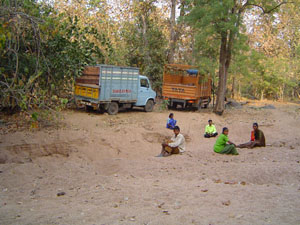 We moved through the forest towards Udhampur to reach the machaan. On our way we came across a dried forest stream. There were some people sitting on the riverbed. We wondered who they were. On closer examination we found them
to be taking sand in tractors. Imran and Asif went to inquire from them. The people said they worked for a contractor from Utnoor and took the sand in the tractors which will then be sold in Hyderabad for construction work. We asked them, ‘isn't sand mining
illegal?' they said, ‘yes'. Then don't you get caught by the forest department?' they said, ‘we pay Rs.200 for each trip to whosoever is on duty'. We took some photographs of the mining activity. Then we went up on our way. There was a lake just before we
reached the village border. It had some good bird life. It was getting dark. There was a discussion, whether we should go to the machaan, or if we should head back to Jannaram. Then one of the members of the team said, ‘let us go and see if the jeep has come
to Udhampur, if it is there, then we can still make it to the machaan in time'. So we went towards the village in search of Linganna and to find out if our jeep has arrived from Jannaram to pick us up. We moved through the forest towards Udhampur to reach the machaan. On our way we came across a dried forest stream. There were some people sitting on the riverbed. We wondered who they were. On closer examination we found them
to be taking sand in tractors. Imran and Asif went to inquire from them. The people said they worked for a contractor from Utnoor and took the sand in the tractors which will then be sold in Hyderabad for construction work. We asked them, ‘isn't sand mining
illegal?' they said, ‘yes'. Then don't you get caught by the forest department?' they said, ‘we pay Rs.200 for each trip to whosoever is on duty'. We took some photographs of the mining activity. Then we went up on our way. There was a lake just before we
reached the village border. It had some good bird life. It was getting dark. There was a discussion, whether we should go to the machaan, or if we should head back to Jannaram. Then one of the members of the team said, ‘let us go and see if the jeep has come
to Udhampur, if it is there, then we can still make it to the machaan in time'. So we went towards the village in search of Linganna and to find out if our jeep has arrived from Jannaram to pick us up.
( To be continued)
Photo credits: Pugmarks by Asif Siddiqui, Sand mining by Saraswati Kavula
* District Forest Officer
**Integrated Tribal Development Agency
|